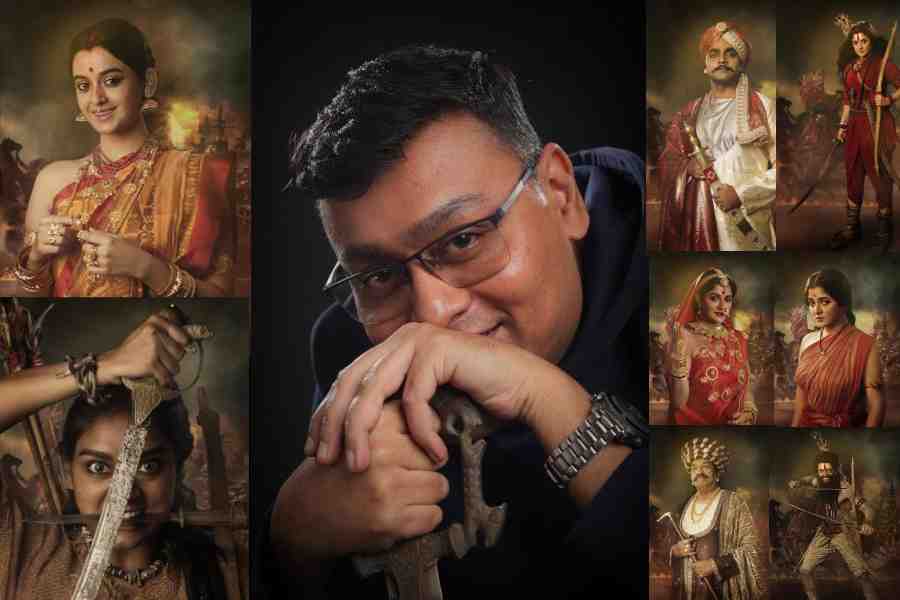After winning the National Award for Avijatrik, film-maker Subhrajit Mitra is all set to direct his next period piece, Devi Chowdhurani — Bandit Queen of Bengal, which narrates the journey of a simple village girl who eventually becomes the first Indian woman freedom fighter. Subhrajit decodes the look of the main characters from the film, produced by ADited Motion Pictures.
Srabanti as Devi Chowdhurani
The entire costume is hand-woven and organically dyed. The primary colours are different shades of red and brown. Devi Chowdhurani was inducted into the team of Sanyasi bandits, mentored by Bhavani Pathak who belonged to the Dashnami sects. They worshipped Shiva and the mother Goddess and practised occult. So they must have worn red primarily in their attire and lots of rudrakshas. The tilak on the forehead of Devi Chowdhurani consists of Haridra, Swet Chandan, and Rakta Chandanin accordance with the tradition of these sects. She is carrying a tribal bow and arrows and quiver, made out of bamboo and jute which were in abundance in Barendrabhumi. She is wearing customised shoes and leg protectors made out of jute and tree bark, as Hindu monks didn’t wear leather and women were forbidden to wear shoes but these Sanyasi bandits needed to protect their feet during the raids in the jungles and hills. She is also carrying a large Indian sword (talwar) and two daggers, expectedly looted from any Indian zamindar, though the shiny scabbards are covered in jute to camouflage. She wears her sari in such a way that it is easier for her to mount a horse or to jump. She is wearing a cotton Angrakha inside, probably part of any earlier loot by the team. She is also wearing shakha, pola, noa and sindoor.
Srabanti as Profullo
Profullo’s wedding attire. The entire jewellery, in gold, was designed in accordance with that time period. The Benarasi sari is also handwoven. Another look of Profullo when she was abandoned by her in-laws. This was sometime after the Great Bengal Famine of 1770. The sign of poverty is prominent in her attire.
Sabyasachi Chakrabarty as Zamindar Haraballav Roy
Benuda’s attire was inspired by Raja Rammohon Roy. The way elite Bengalis used to dress up during that time. It has more of Mughal and Nawabi influence. The fabrics are muslin, silk and cotton. All hand-woven and organically dyed and painstakingly embroidered. Haraballav is a dark character, so the colour palette is mostly grey and brown, and dark chocolate.
Bibriti Chatterjee as Nishi
She is a tribal warrior who was inducted into the team. Fierce and brutal. She is wearing a cotton hand-woven sari and jute body armor underneath. Her eyes are green. She is also armed to the T.
Arjun Chakrabarty as Rangaraj
Rangaraj is a fierce warrior monk who belongs to the Dashnami sect, armed to the T. He is mostly barebodied and wears a short dhoti for easy and swift movement. Other traditional signs of his sects are prominent in his get-up. He has an old deep wound on his left shoulder, a sign of his earlier battles.
Kinjal Nanda as Brojeswar Roy
He’s wearing pure Bengal silk, hand-woven and embroidered. This is a ceremonial getup. The elite Bengalis used to wear headwraps in any official or ceremonial getups. A bit of Mughal as well as North Indian influence. Lots of jewellery as accessories. Brojeswar is a pure soul, so the base colour of his attire is primarily in different shades of white, cream and yellow. Red adds a regal touch to it.
Darshana Banik as Sagar
She is wearing a handwoven Baluchori sari with gold embroidered Geet Govindam scenes all over. She is also wearing custom-made joroa and gold jewellery of that era. The base colour is yellow, the lightest hue of the spectrum, which signifies joy, happiness, imagination, and hope.
Look design: Somnath Kundu
Costume design: Poulami Gupta










